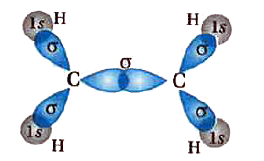Sub. Que. : Explain σ-bond formation in ethene.
Text Solution
Now one sp orbital of carbon combine with sp orbital of other carbon and form sigma bond. Remaining two sp2 orbital. Combine with is orbital of H and form four C-H sigma bond. In this way four C-H sigma bond and two carbon & four Hydrogen are in one plane

Now the each carbon has one non hybride 2p orbital which side by side overlap and form π-bond.
in ethene both carbon has sp2 hybridization . So ethene is planar.

|
Topper's Solved these Questions
- CHEMICAL BONDING AND MOLECULAR STRUCTUREBOOK - KUMAR PRAKASHANCHAPTER - CHEMICAL BONDING AND MOLECULAR STRUCTUREEXERCISE - TRY YOUR SELF-3
1 Videos
- CHEMICAL BONDING AND MOLECULAR STRUCTUREBOOK - KUMAR PRAKASHANCHAPTER - CHEMICAL BONDING AND MOLECULAR STRUCTUREEXERCISE - TRY YOUR SELF-4
1 Videos
- CLASSIFICATION OF ELEMENTS AND PERIODICITY IN PROPERTIES BOOK - KUMAR PRAKASHANCHAPTER - CLASSIFICATION OF ELEMENTS AND PERIODICITY IN PROPERTIES EXERCISE - Section -D SOLUTIONS OF NCERT EXEMPLAR PROBLEMS (Long Answer Type Questions )
7 Videos
Similar Questions
Knowledge Check
The skeleton made up of the σ-bonded atoms in ethene is planar because the C's use
Asp2HO'sBsp3HO'sCspHO'sDdsp2HO'sThe outer orbitals of C in ethene molecule can be considered to be hybridized to given three equivalent sp2 orbitals. The total number of sigma (σ) and pi (π) bonds in ethene molecule is
A3 sigma (σ) and 2 pi (π) bondsB4 sigma (σ) and 1 pi (π) bondsC5 sigma (σ) and 1 pi (π)bondD1σ(sigma)and2π(pi) bonds
Explain the formation of chemical bond.
View SolutionExplain the formation of chemical bond.
View SolutionThe outer orbitals of C in ethene molecule can be considered to be hybridized to given three equivalent sp2 orbitals. The total number of sigma (σ) and pi (π) bonds in ethene molecule is
View SolutionCan a π− bond be formed without the formation of a σ− bond. How many σ−andπ− bonds are formed in acetylene?
View SolutionCan a π− bond be formed without the formation of a σ− bond. How many σ−andπ− bonds are formed in acetylene?
View SolutionExplain the nature of the covalent bond using the bond formation in CH3Cl.
View Solution
